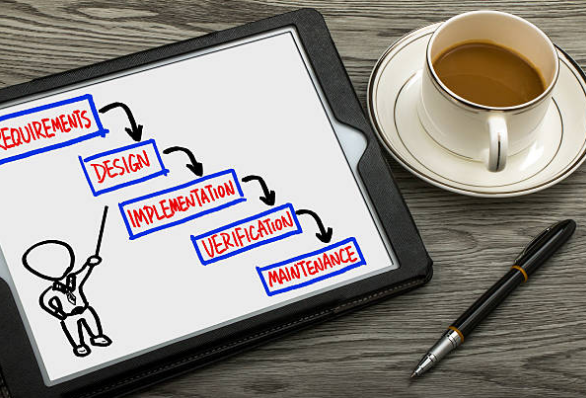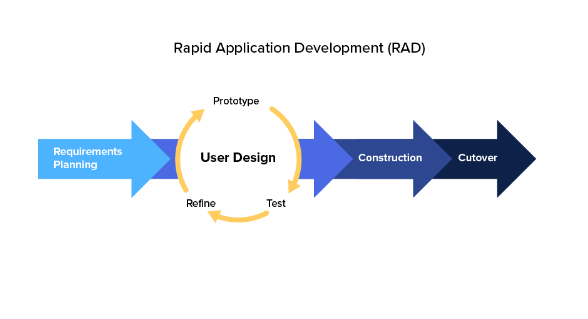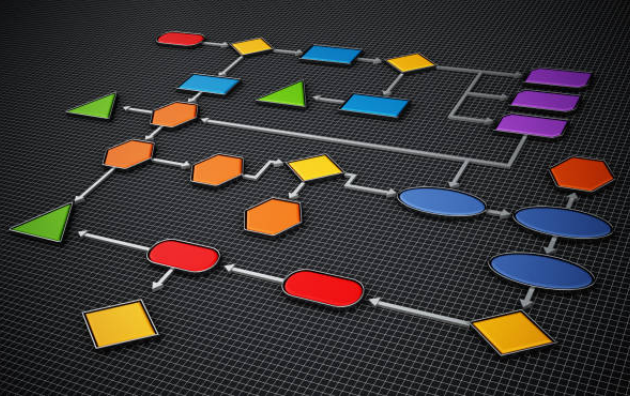From planning to deployment, software development is a complex process that requires absolute concentration and active collaboration within a team, which can be achieved through implementing the right software development methodology.
Different software development methodologies have their strengths and weaknesses, and it’s essential to select an approach that can secure the best possible results.
What Is Software Development Methodology?
A software development methodology is a structured approach to software development, a framework using which a development team can effectively plan and manage the process of building software.
Software development methodologies often combine clear steps with unique process philosophy. Selecting the right methodology translates into a more accurate project timeline, utmost efficiency, higher quality of the final product, and, as a result, greater client satisfaction.
Popular Software Development Methodologies
Depending on the project requirements and stakeholders’ needs, it’s crucial to pick a methodology that can satisfy them to the greatest possible extent. In addition, development teams can combine several software development methodologies to achieve the best results. So what can you choose from? Let’s take a closer look at ten most popular methodologies as of 2022.
1. Agile
Brief Overview
Today, Agile is one of the most common software development methodologies. It is renowned for its revolutionary approach to software development, radically different from the conventional linear model. The Agile methodology aims at satisfying users rather than focusing on documentation.
The Agile approach suggests breaking tasks into short sprints lasting from 1 to 4 weeks. At its core, Agile is an iterative approach, meaning it involves continuous testing and making changes based on customer feedback. Last but not least, any Agile framework is anchored in close communication between team members, customers, and users.

Pros
- greater customer satisfaction as a result of rapid, continuous delivery
- close interaction between customers and developers
- making changes easy when the client’s requirements change
- direct communication and a robust feedback loop eliminate any guesswork
Cons
- less attention to documentation can lead to some issues in the development process later on
- for complex projects, it can be hard to assess the required effort at the initial phase of the software development life cycle
- a massive focus on feedback makes the process lengthier
- because of its non-structured nature, Agile calls for experienced developers able to work independently.
2. Waterfall
Brief Overview
Waterfall is the most commonly used software development methodology, and is considered a classic approach to software development. The Waterfall method suggests managing software development in a linear sequential flow with a primary focus on quality.
It involves planning, collecting requirements, designing and building software, testing and debugging, and, finally, deploying the solution. You can’t start the next phase unless the previous one is completed. The Waterfall methodology doesn’t allow you to go back to earlier phases to make changes if requirements change.

Pros
- the Waterfall model is relatively straightforward and suitable for beginner developers
- due to its rigidity, Waterfall considerably streamlines project management
- more accurate timelines
- effective requirements planning
- streamlined testing
Cons
- no customer feedback predicted in the early phases, increasing the risk of the project falling short of expectations
- testing is done only at the end of the development, some issues being challenging to fix at a later phase
- not suitable for projects that may involve changing requirements
- documentation takes much time
3. Lean
Lean development methodology places a principal focus on developing change-tolerant software. The fundamental Lean principles include customer satisfaction as a major goal, offering the best value for money, encouraging active human interaction, and flexibility in making changes. Lean developers identify bottlenecks that could hinder software development in advance in order to secure an efficient, flawlessly-working system.

Pros
- resource optimization through minimizing documentation and repetitive tasks
- reduced development cost
- faster time to market due to increased efficiency
- stronger motivation within the team as developers have more decision-making power
Cons
- the success of the project crucially depends on how disciplined the team members are
- excessive flexibility can result in developers losing focus
- not suitable for organizations that don’t have a business analyst on board
4. Extreme Programming (XP)
Extreme programming, also known as XP, is a software development methodology focused on frequent releases of software, allowing developers to implement changes based on new requirements with each version.
This approach relies heavily on regular customer feedback and transparent communication to ensure all stakeholders are on the same page. Extreme programming is an iterative methodology, where each iteration consists of four phases: planning, designing, coding, testing, and listening to feedback.
Pros
- this is an excellent methodology if you focus on saving costs and time
- writing simple code that can be improved at any moment
- transparent processes: developers set goals and show progress
- regular feedback that secures higher product quality and meeting customer expectations
- shorter development cycle due to continuous testing
Cons
- focusing on the code rather than on the design
- lack of documentation can lead to unexpected failures that can’t be tracked
- it’s challenging to implement if team members are separated geographically
- stress associated with working to tight deadlines
5. Feature-Driven Development (FDD)
Feature-Driven Development, or FDD, belongs to iterative software development models. FDD suggests allocating development tasks based on the key product features, following five steps in creating feature sets within short timeframes:
- Developing the overall model.
- Drawing up the list of features.
- Planning by feature.
- Designing by feature.
- Building by feature.
Basically, a developer’s to-do list comprises a list of features that the final product is intended to have. The major goal of this methodology is to develop high-performing software within the established timeframes. Each feature usually takes around two weeks to complete.

Pros
- fewer meetings and less time for software development
- compatible with big and small, short and long projects
- breaking work down into smaller sets makes it easier to spot and fix errors
Cons
- doesn’t work for projects with one developer
- heavy dependence on the head developer
- providing customers with little written documentation
6. Rapid Application Development (RAD)
As its name suggests, the Rapid Application Development (RAD) methodology focuses on fast development, which makes it the best fit for building limited-distribution bespoke software. Faster development times are achieved through reusing software components, user testing, and keeping reviews and team meetings informal.
The RAD approach entails four phases: requirements planning, prototyping, testing, and implementation. Unlike the conventional linear methods, RAD involves creating prototypes based on given requirements and testing them with the customer, which is done as many times as needed until the customer is satisfied with the result.

Pros
- minimizing risks thanks to regular customer feedback
- greater customer satisfaction
- well-suited for small and medium software development projects
- quicker time to market
Cons
- the success of the project largely depends on the level of customer engagement
- more difficult to manage if compared to other software development methodologies
- requires highly-skilled and experienced developers
7. DevOps
DevOps refers not only to a software development methodology but also to a series of practices supporting organizational culture. The DevOps approach lays major emphasis on an organizational shift to boost collaboration between the departments responsible for various sides of the development life cycle.
With DevOps, Development and Operations function as a single team, which inevitably translates into greater customer satisfaction, better product quality, and higher productivity.
Pros
- faster time to market
- higher productivity and process efficiency
- clear product vision
- increased product quality
Cons
- requires a proper mindset across the organization
- it might be challenging to get the right pool of DevOps expertise
- transition to DevOps is associated with organizational and technical challenges
- it’s a costly model
8. Prototype Model
The Prototype methodology is a software development approach that lies in creating only prototypes of products to demonstrate their functionality to the clients. This way, the Prototype method allows you to make any modifications before developing the actual solution. Each prototype undergoes customer testing, and, based on feedback, several iterations are carried out to refine the prototype until the customer is satisfied.
Pros
- close to zero product failure rates thanks to eliminating potential issues in the early development stage
- close collaboration with the customer
- gathering a lot of detailed information at the prototype stage, which can later be used in developing the final version
Cons
- increased development time because of the excessive customer testing
- customer’s expectations of the final version might not tally with the prototype
- not suitable for projects with changing requirements
9. Spiral Model
The Spiral model focuses on determining and minimizing project risks as early as possible. This methodology suggests starting development on a small scale and exploring potential risks. Then, developers should come up with a plan to manage those risks and decide whether to take the next step.
In the Spiral methodology, the software development process consists of four phases: planning, risk analysis, development, and evaluation. The development team members go through these phases in a spiral. After each circle, they move to another iteration to further refine the product.

Pros
- fast and cost-effective development
- well-suited for complex projects
- easy monitoring
- thorough risk analysis helps avoid risks
- suitable for projects with changing requirements
Cons
- there’s a risk of not meeting the deadline and/or budget
- it’s imperative to strictly follow the spiral model protocol
- not suitable for small or low-risk projects
10. Dynamic Systems Model
Dynamic Systems methodology is based on the Rapid Application Development (RAD) that we have already discussed. It uses an iterative and incremental approach that largely focuses on constant user involvement. The primary goals of this methodology are timely delivery and synchronizing project goals with business needs.
The Dynamic Systems Model comprises four iterative phases: feasibility and business modeling, functional model, design and build, and implementation. This approach greatly relies on user feedback in the process of software development, which eliminates the risk of drifting away from the project goals and requirements. Lastly, the Dynamic Systems method requires detailed documentation.
Pros
- more effective control over the development timeline and budget
- detailed documentation that can come in handy when managing issues
- open communication between developers and end-users, which considerably reduces misunderstandings
Cons
- expensive to implement due to deep users’ and developers’ involvement, which means extra budget spent on training
- not suitable for small teams
- complex concept and implementation
How To Choose the Best Software Development Methodology
Without any doubt, sticking to one of the software development methodologies is a sure-fire way to add structure and efficiency to your software development workflow. All types of software development methodologies have their benefits and drawbacks, meaning that there’s no one-size-fits-all model able to secure the best possible outcomes. Still, some steps that can help you make an informed decision.
1. Assess Requirements Flexibility
Software development methodologies differ in the way they handle changing requirements.
For instance, if there are high chances of frequent changes in requirements, the Agile approach looks like the most reasonable solution. On the contrary, a traditional software development method such as Waterfall is the best fit for a project with clearly defined requirements that won’t change.
2. Estimate Your Team Size
Some software development methodologies may not work either with smaller or bigger teams. So before you choose your software development methodology, make sure it is compatible with the number of developers needed for your project.
3. Identify Your End-Users
Your end-users also determine your choice. For instance, if your product is targeted at a diverse audience, you’ll receive plenty of requests to add new features to the software after it has gone live. In this situation, it’s best to consider a methodology that lets you step back and edit your product.
4. Decide on the Timeframe
Software development methodologies can be divided into two types according to how much control over the timeframes they give you. For instance, iterative-based methodologies are the best choice for projects with tight deadlines.
5. Understand Your Budget
The budget often determines the complexity and requirements of a software project. Given that, make sure you pick a methodology that aligns with these aspects.
Final Thoughts
Software development methodologies go a long way towards effectively guiding teams through the software development process. Without any doubt, selecting the proper methodology plays a fundamental role in a project’s success. Still, no option would work effectively with every project. You should choose your methodology based on your team size, project requirements, timeframes, target audience, and budget.










